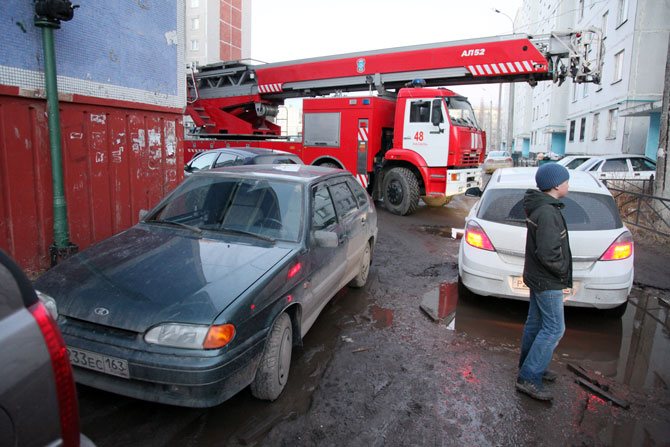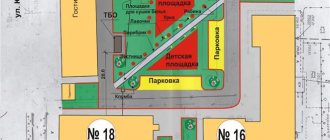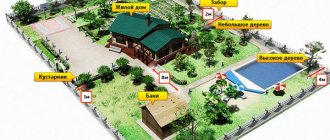Is it possible to install a barrier in the courtyard of a residential building?
The housing complex of the Russian Federation allows you to install a barrier in the courtyard of a residential building. But the actions of residents must be strictly regulated. To do this, they need to legalize their homestead ownership.
Stages:
- Holding a meeting of citizens living in the apartment building. According to Art. 44 of the Housing Code of the Russian Federation, the meeting acts as a governing body. 51% of the votes from those participating in the meeting are enough to make a decision on the installation.
- Since the Housing Code of the Russian Federation designates the local area as property (shared), residents must register it in the cadastre for full use.
- After a decision has been made by the majority of citizens, it is necessary to collect documents and submit them to the authorized bodies in order to register the local land in the cadastral register. It must be registered with the residents. Otherwise, permission to install the barrier will not be issued. From the moment the local area is registered, it is removed from the city’s balance sheet.
Thus, it is possible to install a barrier in the courtyards with the help of a general meeting at which the residents of the apartment building vote. A protocol is drawn up on the decision made. At the meeting, a responsible person must be appointed to represent the interests of residents in government agencies. After making the appropriate decision, a document is drawn up reflecting the cost of a certain barrier model and indicating its technical characteristics. Data on the barrier system are indicated in the protocol.
An application is submitted to the municipal authorities, which indicates the desire of the residents to install the fence. The application is accompanied by the documents necessary for its installation: a protocol with design documentation and a permit issued by the authorized bodies. These are the Fire Inspectorate and the Traffic Police.
Obtaining Permits
From the district administration
To obtain permission to install a barrier in the yard, you must first obtain a decision from the council of deputies of the municipal district or the district administration. To do this, a plan for installing a fence near the house is submitted to the council of deputies of the municipal district. Permission or refusal can be issued by the council up to 30 days. Usually, in new houses where a fence around the house is planned, the administration approves the installation of a barrier without any problems. The only thing they can require is the presence of security or watchmen for quick and unimpeded access for emergency services.
The following factors may cause installation failure:
- If the standards for the unhindered passage of special transport (ambulance, fire truck, law enforcement agencies, emergency services, public utilities) are not observed.
- If the barrier prevents the passage of pedestrians or public transport to public places.
This decision is received by an authorized person. If the decision is approved, but over time the above reasons appear or the barrier interferes with construction, then the fencing device is demolished.
From the traffic police
Article 15 of the Russian Federation Traffic Regulations prohibits the independent placement of structures, barriers, road or similar signs that interfere or impede travel. According to this fact, it is necessary to prove that the area of the local area is not a road, so the installation of a barrier does not violate Article 15 of the Traffic Regulations of the Russian Federation. Everything is simple here. The road that enters the site of an apartment building is not intended for through traffic.
From utilities
Public service authorities just need to take into account that the barrier will not be located in the area where power transmission lines and main pipes are laid.
From the fire services

A big disadvantage during installation is the prohibition by the fire safety service. In its refusal, the fire safety service relies on the rules of PPB 01-03. The rules state that access to structures must be unobstructed. Therefore, in order to install a barrier in the local area, you need to consider an employee or a watchman, and this is a monthly cost. Moreover, fire service employees warn that the fence must be open until the car approaches the local area. Otherwise, you will face a fine, plus firefighters will simply demolish the fencing device without paying compensation. The fine for illegally placing a barrier ranges from 1,000 to 150 thousand rubles, depending on who breaks the law (individual or legal entity).
Which services do you need permission to install?
Installation of a barrier device should not violate the rights of citizens, nor create obstacles to the entrance to the yard and to the house. Permission must be obtained from the following authorities:
- State traffic inspectorate.
- Fire Department.
If you do not obtain permission from the authorized bodies, the owners will pay a fine for illegal installation.
Permission from the city authorities
Permission must be obtained from local authorities. Applications from residents are processed within approximately 30 days. The reasons for refusal are:
- the barrier interferes with the movement of special-purpose vehicles;
- interferes with the free passage of pedestrians;
- interferes with public transport traveling to public areas.
Fire department approval for barrier installation

A barrier in the courtyard of a high-rise building should not become an obstacle for a fire truck
On the issue of ensuring fire safety, it is necessary to rely on the resolution of the executive body - the Government of the Russian Federation. In 2012, this legal act was adopted under number 390.
The fire department, when coordinating the installation of a barrier device, essentially makes one requirement. The main thing is that the barrier does not interfere with the entry of fire department vehicles into the yard. If an obstacle still exists, permission will not be given.
If the barrier is installed without permission, then firefighters in the event of an emergency with fire can ram the barrier device and will not incur financial sanctions for this.
The fire department needs to prove what the barrier will be like to clear vehicles for emergency services to pass through. This can be done in any way:
- Place a security post next to the barrier. Establish 24/7 duty. This method is the most reliable. But it also has a drawback: residents will have to spend money on the salary of a security guard who will regulate the barrier and also equip a workplace for him.
- Install video surveillance. In real time, the opening and closing of the system will be sent to the dispatcher's console. You can consider having the barrier open from a cell phone number.
Permission from the traffic police
Permission from the traffic police is a mandatory procedure. But it is not fraught with difficulties. This is explained by the fact that the local area does not belong to roads. And the yard is not intended for through traffic of vehicles. Based on this, the installation of a barrier will not violate Art. 1.5 Traffic regulations. The article talks about the prohibition of independent placement of signs and structures that impede the movement of traffic.
Rules for installing a barrier
The government issued Resolution No. 834 of July 9, 2020, which established the powers of residents of apartment buildings to improve their courtyards.
It is important to arrange the installation of a barrier without breaking the law. Owners of apartment buildings have the right to improve traffic flow in the yard.
To do this, you need to comply with a number of requirements:
- hold a meeting of apartment building residents, collect signatures for consent to install a barrier;
- the compiled minutes of the meeting are transferred to the BTI for assignment of a cadastral number
- adjacent area, after which this territory is registered for the residents;
- Be sure to obtain permission from the traffic police and fire department.
To hold the meeting, a responsible person is selected, who then needs to go to the authorities with a package of documents to obtain permission. All actions are legal if there are more than 50% of those who voted for the installation.
Conditions for obtaining permission to install a barrier
The installation of a barrier device should not interfere with the entry of ambulances, firefighters, or gas workers.

Fire services allow the installation of a barrier, making sure that during a call, unhindered entry of fire trucks into the yard will be ensured. To do this, residents will have to provide additional costs for paying a security guard. In emergency situations, the barrier must be opened instantly, otherwise it may be rammed by special purpose vehicles without reimbursement.
Important! Permission from the traffic police to install a barrier is issued if there is no through traffic through the yard. Otherwise, there are no obstacles, since the local area does not belong to roads.
Reasons for demolishing the structure
There are installation rules that must be followed to avoid a complaint. If the construction is installed against the law, disagreeing residents contact the district administration and other authorities, such as the traffic police, the Ministry of Emergency Situations, where they take a sample application to draw up an appeal.
The demolition of the parking barrier is being considered on the basis of Article 55.32 of the Civil Code of the Russian Federation, on unauthorized buildings.
They find out whether it is legal to install a barrier in the yard and decide to dismantle the barrier. In addition to this instruction, a fine will be charged from responsible persons if the legality of actions is violated.
Important! The illegal structure is dismantled after the decision.
General procedure for installing a barrier in the courtyard of a residential building
Stages:
- Citizens who are the owners of apartments in a multi-storey building gather. According to Art. 44 of the Housing Code of the Russian Federation, the general meeting is the governing body of the house. To make any decision, 51% of the votes of those participating in the meeting are required in order to erect a barrier.
- Residents register their local area in the cadastre for full use.
- After approval of the installation of the barrier by a majority vote, documents are prepared and submitted to the authorized bodies for registration of the adjacent land on the cadastre. The adjacent territory is registered for the residents. From the moment the land plot is registered, it will no longer be listed on the city’s balance sheet.
How to organize a meeting of owners to discuss issues
In order to gather residents, it is necessary to make some efforts. Not all residents are interested in the topic of installing barriers. In order to gather people, you need:
- Enlist the support of neighbors, who often bring various issues of landscaping the area around the house to a vote.
- Set a date and time for the general meeting.
- Prepare the topic of the day.
- Collect information about apartment owners and notify them of the meeting.
- Send them email alerts.
- Notify local authorities of the meeting.
- Count the number of votes for each owner.
- Prepare ballots.
- To hold a meeting.
- Vote, collect ballots.
- Count the votes.
Based on the vote count, a protocol is drawn up, where the topic and issue under discussion are entered. And also the voting result. The document is submitted to the Housing Inspectorate.

To install a barrier in the yard of a residential building, a vote will be required
How legal is it to install a barrier at the entrance to a yard?
Not all apartment building residents (some of whom may not be apartment owners) agree with this situation. An analysis of citizens' appeals on this issue allows us to conclude that in most cases, the installation of a barrier at the entrance to a yard is carried out in violation of the norms of current legislation.
The following regulations and legal positions of the highest courts apply to relations related to the installation of locking devices at the entrances to the courtyard of apartment buildings:
Part 1 of Article 246 of the Civil Code of the Russian Federation: “The disposal of property in shared ownership is carried out by agreement of all its participants”;
Clause 1 of Part 4 of Article 36 of the Housing Code of the Russian Federation: “The owners of premises in an apartment building own, by the right of common shared ownership, the common property in the apartment building, namely... the land plot on which the house is located, with elements of landscaping and landscaping, other intended for maintenance , operation and improvement of this house and objects located on the specified land plot”;
Part 2 of Article 36 of the Housing Code of the Russian Federation: “owners of premises in an apartment building own, use and, within the limits established by this code and civil legislation, dispose of common property in an apartment building”;
Part 5 of Article 16 of Federal Law No. 189-FZ of December 29, 2004 “On the entry into force of the Housing Code of the Russian Federation”: “from the date of the state cadastral registration of the land plot on which the apartment building and other objects included in such a house are located real estate, such a land plot passes free of charge into the common shared ownership of the owners of premises in an apartment building";
paragraph 67 of the joint resolution of the Plenums of the Supreme Court of the Russian Federation and the Supreme Arbitration Court dated April 29, 2010 No. 10/22 “On some issues arising in judicial practice when resolving disputes related to the protection of property rights and other property rights”: “if land the site has not been formed and state cadastral registration has not been carried out in relation to it; the land under the apartment building is owned by the corresponding public legal entity. The owners of premises in an apartment building have the right to own and use this land plot to the extent necessary for their operation of the apartment building, as well as the objects that are part of the common property in such a building. When determining the limits of the powers of the owners of premises in an apartment building to own and use the specified land plot, it is necessary to be guided by Part 1 of Article 36 of the Housing Code of the Russian Federation. In these cases, the owners of premises in an apartment building, as the legal owners of the land plot on which this house is located and which is necessary for its operation, by virtue of Article 305 of the Civil Code of the Russian Federation, have the right to demand the elimination of any violations of their rights, even if these violations were not associated with deprivation of possession, as well as the right to defend one’s possession, including against the owner of the land plot.”
It is also worth noting the following:
- regulations regulating the issues of fencing adjacent areas have also been adopted in some constituent entities of the Russian Federation. As an example, we can cite the Moscow Government Resolution No. 428-PP dated July 2, 2013 “On the procedure for installing fences in local areas in the city of Moscow”;
- restrictions on entry into the local area not only affect the rights of owners to dispose of the land plot, but must also comply with the requirements of public law norms. For example, Decree of the Government of the Russian Federation dated April 25, 2012 No. 390 (as amended on March 7, 2019) “On the fire safety regime” (together with the “Fire safety regulations in the Russian Federation”).
Based on the results of the analysis of the above standards, the following conclusions can be drawn:
1. In most cases, land plots under multi-apartment residential buildings are either transferred to the common ownership of property owners in apartment buildings, or their legal regime is similar to the right of common shared ownership.
2. To restrict the passage of cars onto the adjacent land plot, the consent of all owners of premises in the apartment building is required.
3. In some cases, restrictions on the entry of cars into the local area may violate public law norms, for example, fire regulations.
What to do before submitting documents
Before installing a barrier in the courtyard of an apartment building, it is necessary to draw up a protocol on the voting results. And before submitting documents, it is necessary to formalize it, reflecting in the document the topic of discussion and the number of votes of people who approved the initiative.
Package of documents for installation permission
Based on the vote on a barrier in the courtyard of a residential apartment building, minutes of the general meeting are drawn up. It reflects information about the following:
- election of a responsible citizen who will represent the interests of residents in government bodies;
- how the device will be installed;
- choosing a place for it;
- barrier characteristics;
- choosing a place for it;
- deciding whether residents will apply for installation subsidies.
In addition to the protocol, the set of necessary papers includes:
- project for land surveying of the local area;
- application for approval of the installation of a barrier;
- project for its placement.
The papers are submitted to municipal authorities. The decision on installation is made within 30 days. From the day the decision is made, it is transferred to the responsible person, who acts on behalf of the owners, and to the management of the district in which the apartment building is located.
How to legally install a barrier in the yard
The number of cars in the city is growing, and not everyone has enough parking spaces.
This encourages residents of various residential complexes to fence off the area around their houses so that strangers do not take up space. How to legally install a barrier in your yard and in what cases can it be dismantled? On the main street of one of the microdistricts of Yekaterinburg - Khalturin - a multi-kilometer traffic jam forms every morning, so some cunning people, trying to save time, drive through courtyards. As a result, the local area turns into a highway.
“Our children go to school here, mothers walk with strollers. Therefore, at the general meeting, we decided, on the one hand, to install three concrete barriers to calm the traffic in the yard, and on the other, to make an entrance with a barrier,” says Valentina Sidorenko, a resident of Yekaterinburg.
But most often, barriers are installed in courtyards to divide the few parking spaces between residents.
“Next to us, a long-term building with 20 floors was being built, it was frozen, unfrozen, and so on in a circle, and then it was put into operation. However, the developers did not provide a sufficient number of parking spaces. Therefore, tenants began to occupy ours. As a result, together with the other apartment owners, we decided to put a fence around the perimeter of the parking lot in our yard and install a barrier at the entrance,” explains Elena Yurskaya, a resident of Yekaterinburg.

But most often, barriers make life easier only for motorists who are worried about their movable property. They only disturb the other residents.
“Recently there was such a case: at night my elderly mother suddenly felt ill, she called an ambulance. The car was supposed to arrive within an hour and a half. We have a barrier on all sides around the house. I don't have a car, so I didn't buy a remote control. But at that moment I realized that, firstly, the ambulance would not come to us, the team would have to walk to the entrance, and secondly, if my mother needed to be taken away, then it was not clear how to open the barrier at night? Knocking on neighbors? And if there was a key, I would still have to go out and open the entrance for the ambulance, and leave a sick person in serious condition alone in the apartment,” says Olesya Eliseeva, a resident of Yekaterinburg.
Residents also note that due to the widespread installation of barriers and fences, it is inconvenient to call a taxi: closed passages are not displayed on maps - drivers do not understand where they need to drive up - they end up parking far from the entrances, so they have to walk to the car.
Housing legislation stipulates that the adjacent territory is the property of the apartment owners. Therefore, they have the right to protect and improve it, including by installing a barrier.
“The main thing is that everything is carried out within the framework of the law. Installing a barrier requires following a certain order. First, a meeting of apartment owners is convened, who draw up a protocol on installing the barrier and putting it into operation. The decision is made by a majority vote. After this, an estimate for the installation of fencing and other necessary equipment is approved, which is attached to the specified protocol,” explains Konstantin Bobrov, director of the legal service “Unified Center for Protection.”

Next, you need to obtain permission to install a barrier from the traffic police, the urban planning department and the State Fire Service of the Russian Federation. Then you should submit a corresponding application to the administration. All accompanying documentation is attached to it:
1) documents confirming the ownership rights of residents to the local area;
2) technical documentation for the barrier and other equipment;
3) cadastral extract of the land on which the local area is located;
4) permits from the traffic police, the State Fire Service of the Russian Federation, the urban planning department;
5) minutes of the meeting of residents at which the decision to install the barrier was made;
6) copies of identification documents of the applicants.
When deciding to install a barrier, residents must comply with the following requirements. For example:
— the fence should not impede the passage of pedestrians;
— the structure should not block the passage of the fire service, police, ambulance, or gas service;
— the barrier must be installed securely so as not to create a danger of harm to people. All structures must be stable and durable;
— it is necessary to select someone responsible for the operation of the equipment, but at the same time it is necessary that every resident of the house has the opportunity to open the barrier.
“It should be noted that if residents do not comply with these requirements, they will be given an order to dismantle the barrier. If they do not comply with this requirement, the owners will be required to demolish the equipment through a court order. In this case, they will incur an administrative penalty (a fine, the amount of which depends on the type of offense committed). Therefore, residents must ensure from the very beginning that the device is supplied in compliance with all conditions,” comments Konstantin Bobrov.
Installing a barrier is a labor-intensive process, but if all its stages are carried out consistently, reliable operation of the equipment and the absence of problems with authorities and your own neighbors will be ensured.
Source: N1
Installation of a barrier in the courtyard of a residential building
A barrier in the courtyard of an apartment building is installed in compliance with mandatory rules. The device should not interfere with access to the entrances of special services vehicles. For these purposes, coordination is carried out with the fire department and traffic police.
If the barrier is installed at the expense of the provided subsidies, then it must be installed within a year from the date of transfer of money to the current account. Within one month. you need to confirm that the work has been done. The official of the Directorate of Housing, Communal Services and Improvement of the JSC must provide the following documents:
- work agreement;
- an act that indicates that a barrier was installed.
Preparatory work
If an initiative group of owners of an apartment building has decided to install a barrier in the yard, it is necessary to gather the residents of the apartments. This is the preparatory stage: important issues are resolved at meetings. If the majority of votes of the owners agree with the opinion of the initiators of the collection, then the residents apply to the BTI in order to put the local area on the cadastre. This is important, since from the moment the land plot near the apartment building is registered, the owners can dispose of it at their own discretion.
Selecting a barrier type
When choosing a barrier device, it is based not so much on personal preferences, but on the practicality of using the barrier.
Installing an automatic barrier in the courtyard of a house allows you to limit car access. Automatic devices are divided into 2 groups:
- electromechanical;
- electrohydraulic.
The difference between one group and another is the type of driving element. In the first group it is an electric motor, in the second there are springs equipped with a hydraulic element.
The advantages of electric barrier devices are:
- strength;
- reliability;
- frost resistance;
- corrosion resistance;
- prompt opening;
- uninterrupted operation;
- control the device remotely;
- ease of installation.
Hydromechanical barriers are characterized by quiet operation of the mechanisms, as well as a higher price compared to the previous version.
Design requirements

Most often, remote-controlled barriers are installed in yards.
Most Russian courtyards are equipped with automatic remote barriers, which indicates their popularity among the population. The device is controlled via a key fob, keys or an electromagnetic sensor. If the power supply is turned off, the barrier continues to operate due to an additional backup source.
When choosing, pay attention to the dimensions of the barrier:
- width;
- type of drive;
- type of control;
- availability of devices that ensure uninterrupted operation;
- boom lifting speed.
In places with inactive vehicle traffic, you can use a barrier whose boom rises in 10 seconds. This criterion is influenced by the length of the mechanism (lifting).
Device control methods
It is managed in several ways:
- a key fob that works similar to a control panel;
- magnetic card;
- cell phone (by subscriber number).
The most affordable way is a key fob, which is always at hand for car enthusiasts. The cost of the keychain is approximately 700 rubles per piece.
Barrier installation steps
In order to make a decision about installing a barrier in the yard, it is necessary to gather the residents. They must vote for this action. More than half of those who agree are required.
It is difficult to gather all the apartment owners in a large building. Therefore, the preparatory stages of installing the barrier were simplified as much as possible. In particular, you can vote for the installation of a barrier device in the yard in the “Electronic Home” system based on the “Active Citizen” project.
After drawing up a protocol based on the voting results, it is necessary to submit the documents to local authorities in order to approve the installation of the structure.
But owners must first decide what type of barrier will be installed in their yard. The technical characteristics of the barrier device are included in the protocol.
Only after agreement with the fire department and traffic police can you buy a barrier and install it. Residents of Moscow have the right to receive a subsidy for the purchase of a barrier device.
Installation of a barrier
When the documents have been collected, all approvals have been completed, the installation of the structure begins.
Follow the following procedure:
- preparation of the territory;
- concreting the equipment installation site;
- assembly and painting of the fence.
Firstly, the area is cleared of plantings and various obstacles for raising the boom to a height of 45°. They maintain a distance from the driveway to a ten-story building of 8-10 meters, and for houses with less than 10 floors, 5-8 meters. In the cleared area, a hole of about 1 m is prepared for the foundation, on the side of the road.
A square-shaped pillar is placed in the prepared recess and filled with cement. The foundation is made strictly horizontally, checking the level. On the opposite side of the road, a small base is poured for the boom holder.
Boom and material selection
The length of the boom depends on the width of the passage. The most suitable from 3 to 12 meters . If the passage is wide, then it is more practical to install a system with two booms on both sides, this will speed up the opening and closing of the barrier.
Also choose the material for the arrow. The lifting mechanism, which must support the weight of the entire structure, depends on it. It is more practical to make an arrow from metal or aluminum alloy.
Assembling the barrier
Electrical wires are prepared for the automatic device. When the foundation hardens, the assembly of the structure begins.
For this you need self-tapping screws, a screwdriver and a drill. All parts are fastened according to the instructions . The more carefully the assembly is done, the more reliable the design during operation.
Subsidy for the installation of a barrier

The cost of installing a barrier can be partially offset by a subsidy
To receive a subsidy, you must contact the Housing and Communal Services Directorate. Hand over documents to officials once. The decision period is 10 days.
By subsidy amount:
- From 53,000 to 100,000 for one barrier device;
- From 200,000 – for 2 barriers;
- From 300,000 – for 3 devices.









